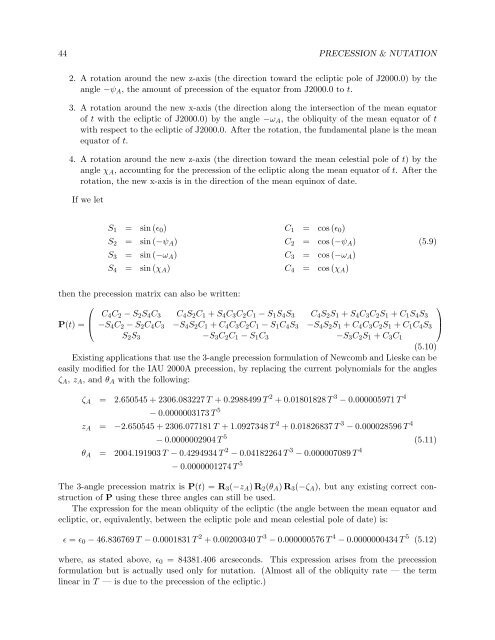USNO Circular 179 - U.S. Naval Observatory
USNO Circular 179 - U.S. Naval Observatory
USNO Circular 179 - U.S. Naval Observatory
Create successful ePaper yourself
Turn your PDF publications into a flip-book with our unique Google optimized e-Paper software.
44 PRECESSION & NUTATION<br />
2. A rotation around the new z-axis (the direction toward the ecliptic pole of J2000.0) by the<br />
angle −ψA, the amount of precession of the equator from J2000.0 to t.<br />
3. A rotation around the new x-axis (the direction along the intersection of the mean equator<br />
of t with the ecliptic of J2000.0) by the angle −ωA, the obliquity of the mean equator of t<br />
with respect to the ecliptic of J2000.0. After the rotation, the fundamental plane is the mean<br />
equator of t.<br />
4. A rotation around the new z-axis (the direction toward the mean celestial pole of t) by the<br />
angle χA, accounting for the precession of the ecliptic along the mean equator of t. After the<br />
rotation, the new x-axis is in the direction of the mean equinox of date.<br />
If we let<br />
S1 = sin (ɛ0)<br />
S2 = sin (−ψA)<br />
S3 = sin (−ωA)<br />
S4 = sin (χA)<br />
then the precession matrix can also be written:<br />
P(t) =<br />
⎛<br />
⎜<br />
⎝<br />
C1 = cos (ɛ0)<br />
C2 = cos (−ψA) (5.9)<br />
C3 = cos (−ωA)<br />
C4 = cos (χA)<br />
C4C2 − S2S4C3 C4S2C1 + S4C3C2C1 − S1S4S3 C4S2S1 + S4C3C2S1 + C1S4S3<br />
−S4C2 − S2C4C3 −S4S2C1 + C4C3C2C1 − S1C4S3 −S4S2S1 + C4C3C2S1 + C1C4S3<br />
S2S3 −S3C2C1 − S1C3 −S3C2S1 + C3C1<br />
(5.10)<br />
Existing applications that use the 3-angle precession formulation of Newcomb and Lieske can be<br />
easily modified for the IAU 2000A precession, by replacing the current polynomials for the angles<br />
ζA, zA, and θA with the following:<br />
ζA = 2.650545 + 2306.083227 T + 0.2988499 T 2 + 0.01801828 T 3 − 0.000005971 T 4<br />
− 0.0000003173 T 5<br />
zA = −2.650545 + 2306.077181 T + 1.0927348 T 2 + 0.01826837 T 3 − 0.000028596 T 4<br />
− 0.0000002904 T 5<br />
θA = 2004.191903 T − 0.4294934 T 2 − 0.04182264 T 3 − 0.000007089 T 4<br />
− 0.0000001274 T 5<br />
(5.11)<br />
The 3-angle precession matrix is P(t) = R3(−zA) R2(θA) R3(−ζA), but any existing correct construction<br />
of P using these three angles can still be used.<br />
The expression for the mean obliquity of the ecliptic (the angle between the mean equator and<br />
ecliptic, or, equivalently, between the ecliptic pole and mean celestial pole of date) is:<br />
ɛ = ɛ0 − 46.836769 T − 0.0001831 T 2 + 0.00200340 T 3 − 0.000000576 T 4 − 0.0000000434 T 5 (5.12)<br />
where, as stated above, ɛ0 = 84381.406 arcseconds. This expression arises from the precession<br />
formulation but is actually used only for nutation. (Almost all of the obliquity rate — the term<br />
linear in T — is due to the precession of the ecliptic.)<br />
⎞<br />
⎟<br />
⎠


